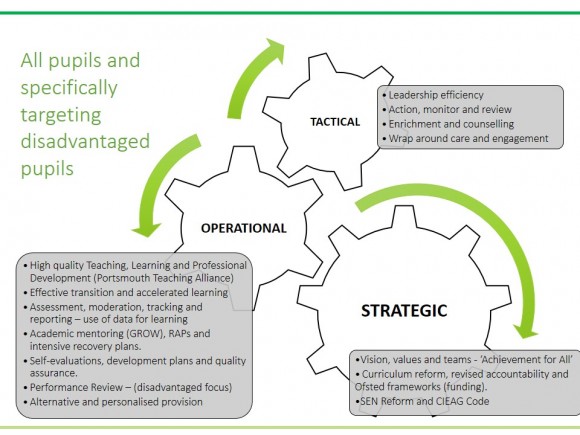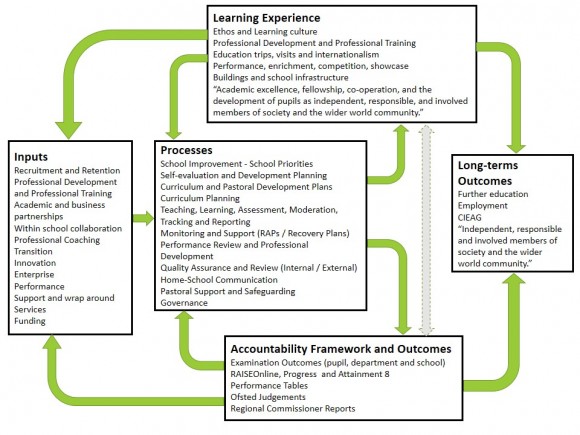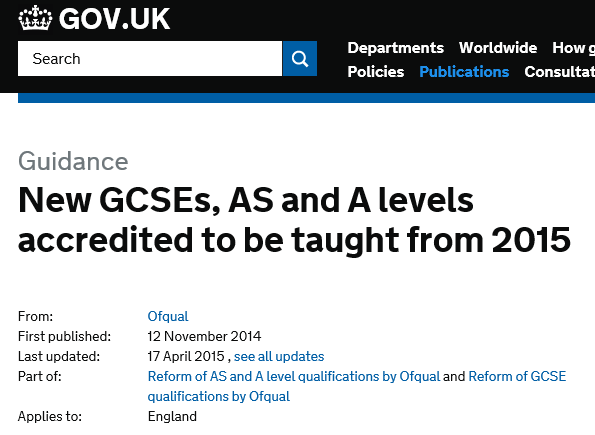Is there collective noun for a group of coincidences? This is a post about four discrete coincidences, the respect for a colleague, a governors meeting, a conference presentation, an interview task, a blog post by John Tomsett, and a tweet from Assistant Headteacher Steve Logan.
At The Wellington Academy, my colleague Rob Wood has been working with our staff, “Achievement for All” and our local disadvantaged pupil achievement advisor, with relentless optimism and industry. He has supported my personal crusade to improve lower school literacy and together we taught Maths (as non-specialists). Can it get more functional? Affirmatively, he has been raising the profile of the disadvantaged pupils, identifying pupils who need the Tesco approach, calling the staff to action. I have been listening and taking part in his teaching and learning briefings, his solution circles, reading his emails, supporting his academic research as well as contributing to his Raising Achievement Plans (RAPs) and recovery programmes (more about those later).
Aside, I was updating a presentation I had written for ASCLs national Deputy Headteacher Conference, “Using data to raise student outcomes,” which I should have re-titled, “Using data to improve the quality of teaching and raise student outcomes,” as we all know, it is high quality teaching and learning that impacts on learning not data. Using data is just one facet of high quality teaching and learning. And data, a key ingredient in effective academic mentoring, nominated for best supporting achievement strategy.
Coincidentally, I have been ask to present my approach to raising the achievement of disadvantaged pupils as an interview task, and the thinking behind these two presentations collided. Whilst, somewhere in the midst of this commotion, John Tomsett’s nailed his colours to the data mast.
Then, yesterday, I presented the report I wrote two weeks ago for our LGB meeting, which reported our forecast Pupil Premium achievement – demonstrating narrowing gaps as we moved down through the school, Y11 to Y7 (The Rob Wood impact). Finally, Steve Logan’s tweet. All coincidental and inextricably connected. You see now why I ask, is there a collective noun for a group of coincidences?
Driving achievement for disadvantaged pupils
When discussing the achievement of disadvantaged pupils, nationally we are discussing a subset of under-achieving pupils. The is our call to action. Act now, act early. The achievement gaps gets wider as pupils get older, when using our KS2 (67%: 83% Level 4) and KS4 measures (27.5 ppts gap (36.5%: 64%) in 5A*-C EM).

STRATEGIC
- Vision, values and teams – ‘Achievement for All’
- Curriculum reform, revised accountability and Ofsted frameworks (funding). Find a curriculum that works for your disadvantaged pupils.
- SEN Reform and CIEAG Code
OPERATIONAL
- High quality Teaching, Learning and Professional Development
- Effective transition and accelerated learning
- Assessment, moderation, tracking and reporting – use of data for learning
- Academic mentoring (GROW), RAPs and intensive recovery plans.
- Self-evaluations, development plans and quality assurance.
- Performance Review – (disadvantaged focus)
- Alternative and personalised provision
TACTICAL
- Leadership efficiency
- Action, monitor and review
- Enrichment and counselling
- Wrap around care and engagement (improve attendance / behaviour, reduce exclusions)
Whole school strategies might include…
- High quality teaching and learning, consistent across the school, supported by a strong Professional Development and coaching culture
- Strategic deployment of staff
- A strong school improvement culture
- An engaging and relevant curriculum, personalised to pupil needs
- Pupil level assessment, (moderation), tracking and reporting system
- Purposeful assessment, moderated marking and high quality personalised feedback – what pupils need to focus on for maximum gain
- Effective celebration, behaviour and attendance policies
- An “Achievement for All,” inclusive and positive school culture
- Effective, distributed and collegiate leadership throughout the school
Targeted strategies for under-achieving pupils might include…
- Pre-assessment, early and targeted learning support (transition and accelerated learning)
- One-to-one tutoring and TAs, Raising Achievement Plans and/or intensive recovery plans
- Rigorous assessment, tracking and evaluation of targeted support
- Extended services and multi-agency support
- Focused academic and personal mentoring (GROW)
- In-school support and counselling and family outreach (especially if excluded)
- Developing confidence and self-esteem through pupil voice, pupil leadership, empowering pupil mentors and enrichment
Targeted strategies for disadvantaged pupils might include…
- Incentives and targeting of extended services, parent and carer support
- Subsidising educational visit and essential learning resources
- Additional residential and summer camps (low impact – it is about relationships)
- Interventions to manage key transitions between stages /schools
- Dedicated leadership advocate
- Supported transition
Now, these are the bare bones. A list tells you very little about operational effectiveness and the tactical work / investment required. (I have seen how hard Rob Wood has work operationally and tactically.)
The motivation for staff investment? Parents of very young children among the top 25% of earners are more than twice as likely to have at least ten books in the home than those from the bottom quartile. Wealthier mothers are also more than 50% more likely to read to their child three or more times a week. Children aged 6 to 7 from richer families are more than twice as likely to be enrolled in special lessons or extracurricular activities compared with their lower-income counterparts. Schools can, and should support our most disadvantaged pupils.
Why data?
In the best schools, the major differences are the extent to which leaders ensure that the funding is very carefully targeted at the types of activities that best meet the needs of their pupils, and the rigour with which these activities are monitored, evaluated and amended.- Christine Raeside, Senior Her Majesty’s Inspector.
Data to successfully to maximise achievement:
- Schools that are committed to ‘closing the gap’ and that have robust tracking systems are showing most improvement” (Ofsted – The pupil premium: an update July 2014)
- use data to analyse progress and the causes of under-achievement
- for research evidence to identify what works for your pupils (I would recommend you start investigating teacher-pupil interaction; feedback, metacognition, peer tutoring.)
- allocate their best teachers to groups with the highest ratio of disadvantaged pupils (RAPs and/or intensive recovery plans/groups)
- give systematic feedback to pupils
- ensure class and subject teachers knew their Pupil Premium pupils and were responsible for accelerating progress (provide prior and contextual data)
- monitor and evaluate impact on pupil results (support analysis)
- involve governors in planning and evaluating
Data for school improvement, for accurate in insightful self-evaluation and thoughtful, assessed and prioritised development planning. Data for Performance Review. Not met/not met achievement targets, but for information and evaluate conversations on teacher effectiveness. Data to assigned ownership and underline responsibility.
Low cost and immediate impact?
- Prioritise the books of disadvantaged pupils when marking
- Set demanding, high and supportive expectations
- Set more challenging homework for the most able
- Plan and direct challenging questions and differentiated tasks for disadvantage pupils
- Spend time identifying barriers to learning of individual most able / FSM6 pupils before you decide what strategies to adopt
- Spend time discussing individual pupils in your team meetings, solution circles are an effective way to share information and discuss ideas
- Don’t just assume that one approach will work or what works for one pupil is needed or required for another (solution circles work well here)
- Signpost the exit routes – aim higher
- Use a staff noticeboard to allow staff to add and share comments on what works with certain, key pupils
- Ask the pupil what works for them
- Consider a range of teachers, other adults, sixth form pupils as academic mentors.
- Connect mentoring with the assessment cycle
Within a school setting, (with the help of Tom Sherrington) it might look something like this?
As for the title of the post, the strategic, operational and tactical cogs. Driving the achievement of disadvantaged pupils must start, IMHO, with an Achievement for All value system, with industrious, persuasive and hardy staff, and the expectations that the gap can be closed.
- Solution circles* – one pupil focused conversation, all the teaching staff.
- RAPs* – Broad review, multi-subjects, academic mentoring.
- Intensive recovery plans* – teacher, motivator and TA. Identify pupils falling behind, or disconnected. Selected for a specialist programme ASPIRE groups. High octane teaching, senior leader involvement and motivation. TA support for pupils who get stuck. Short term.
Improving FSM attainment
Reducing gaps
Improving attendance
Accelerating progress
Reducing exclusions
Improving behaviour
Improving engagement of
families
Developing skills and personal
qualities
Extending opportunities
Good destination data



